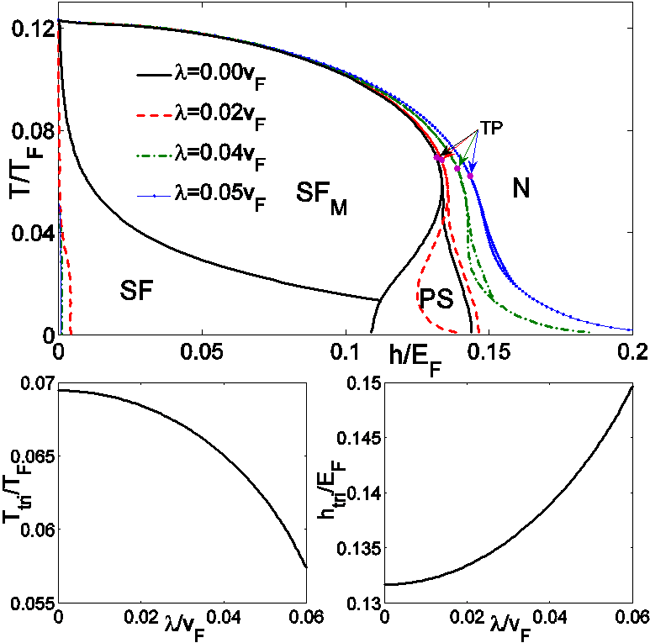The finite-temperature phase diagram of polarized atomic Fermi gas in a synthetic gauge field
Recently, Wu-Ming Liu's group from Institute of Physics Chinese Academy of Sciences/Beijing National Laboratory for Condensed matter Physics has investigated a two-component atomic Fermi gas with population imbalance in the presence of Rashba-type spin-orbit coupling (SOC) induced by a synthetic gauge field. They map out the finite-temperature phase diagram at the BCS side, which reveals a large variety of new features.
In 2009, Spielman's group in NIST first realized a synthetic gauge field in Bose-Einstein condensate (BEC) of 87Rb by controlling atom-light interaction and created an effective spin-orbit coupling (SOC). The engineered SOC, equally applicable for bosons and fermions, allows for the realization of topological insulators and topologically nontrivial states in fermionic neutral atom systems, engendering broad interest in the physics community. Intense theoretical attention has been paid to the physics of the Bose-Einstein condensate-BCS crossover and polarized Fermi gases in the presence of SOC. The SOC has been predicted to lead to various new phenomena.
However, so far, most of the theoretical studies have focused mainly on zero temperature, leaving the physics at finite temperature, which is experimentally relevant, largely intact. In this work, Wu-Ming Liu, Postdoctor Renyuan Liao, and Dr. Yu Yi-Xiang are trying to address this question. They mapped out the finite-temperature phase diagram at the BCS side where mean-field theory gives quantitatively reasonable results. The finite-temperature phase diagram reveals a large variety of new features, including the expanding of the superfluid state regime and the shrinking of both the phase separation and the normal regimes. For sufficiently strong SOC, the phase separation region disappears, giving way to the superfluid state. They find that the tricritical point moves toward a regime of low temperature, high magnetic field, and high polarization as the SOC increases. Then, they examined the physics at unitarity, which is experimentally relevant and theoretically interesting. Specifically, they consider the effect of SOC on the "spin susceptibility" and the critical temperature.
In summary, this work added some new excitement to the surging field of cold atom physics involving an artificial gauge field and Spin-Orbit Coupling. The work was supported by Chinese Academy of Sciences, the National Natural Science Foundation of China, and the ministry of science and technology of China. It has been published in Physical Review Letters 108, 080406 (2012).
Full article can be found at:
http://prl.aps.org/abstract/PRL/v108/i8/e080406.
 |
| FIG. Upper panel: Finite-temperature phase diagram as a function of T and h. There are four different phases: the normal state (N), the phase separation state (PS), the superfluid state (SF), and the magnetized superfluid (SFM). Lower panel: The evolution of the tricritical point (Ttri/TF; htri/EF) as a function of SOC strength λ.(Image by Wu-Ming Liu et al.) |


